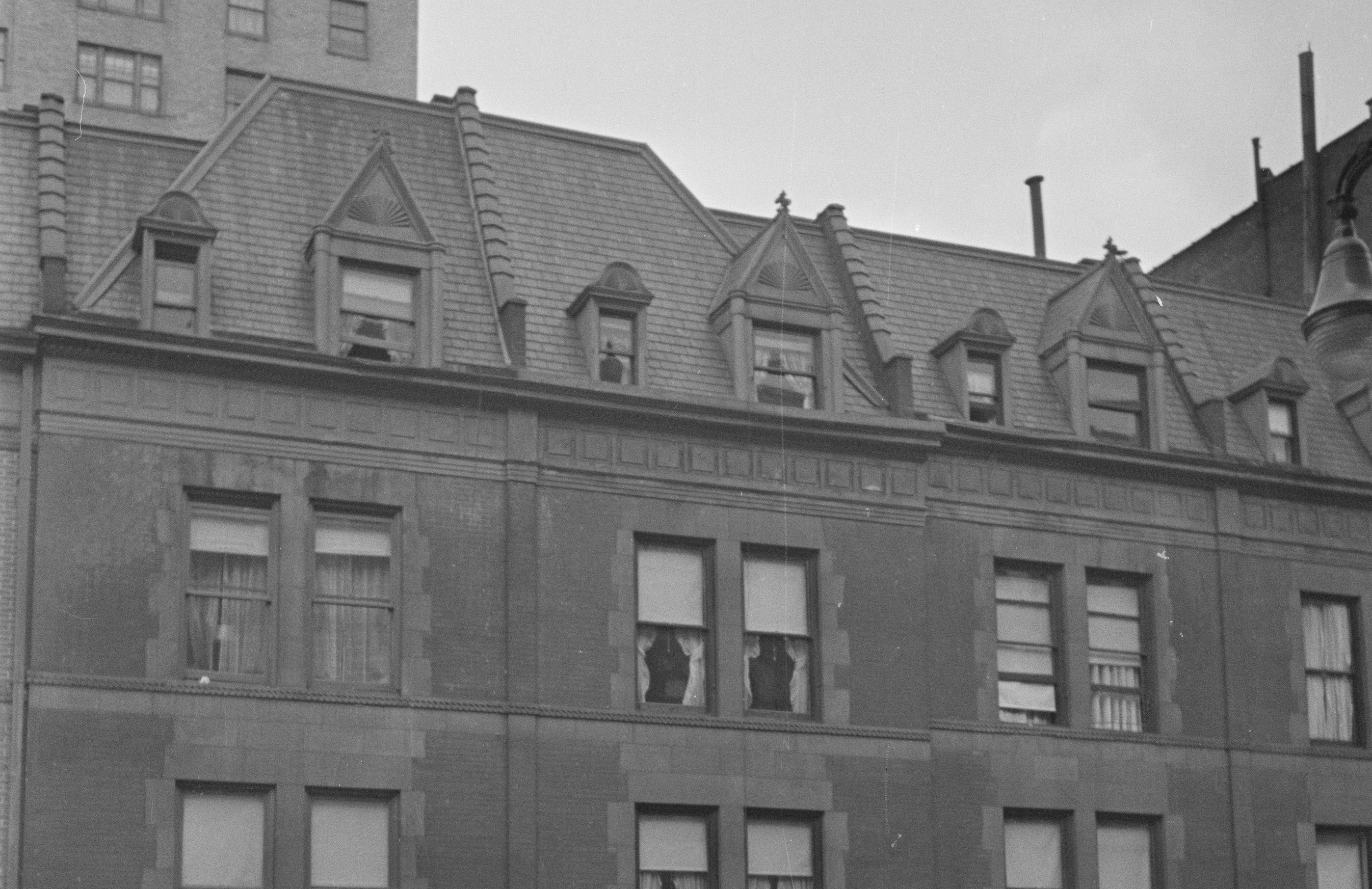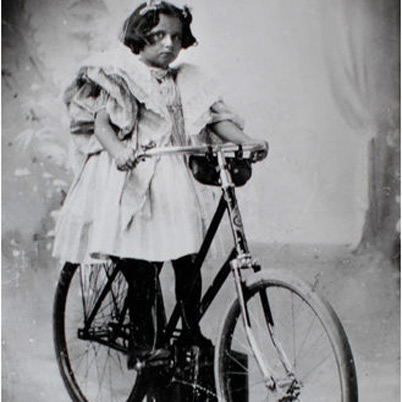
The Virginia O’Hanlon House — 115 W. 95th St.
by Tom Miller
By the late 1880s the block along West 95th Street, between Columbus and Amsterdam Avenues bore little resemblance to the Charles Ward Apthorp estate of a century earlier. Now speculative rowhouses lined the streets, most designed by architects Charles T. Mott and William J. Merritt.
Among the Merritt-designed structures was 115 West 95th Street—one of a string of six somewhat boxy brick-and-brownstone homes that stretched from 111 to 121 West 95th Street built by developer Charles Bouton. A rusticated, rough-cut brownstone first floor served as a base for two stories of red brick. Brownstone quoins framed the paired, centered windows and each peaked, tiled roof was interrupted by a single dormer.
The six harmonious homes were intended for middle-class families, like that of Dennis Moloney, a meat merchant, who moved into 115.
At the time, Dr. Philip F. O’Hanlon was making a name for himself in the medical community. O’Hanlon’s family had a medical tradition—both his father and grandfather practiced medicine on East 18th Street. He earned his medical degree from New York University in 1886 and immediately became House Surgeon at Gouverneur Hospital until 1887. In 1891 he was appointed Medical Examiner in the Insurance Department of the State of New York. But after 1895, when he became the City’s Coroner’s Physician, Philip F. O’Hanlon’s name became a household word.
The doctor and his wife, the former Laura Lincoln Plumb, had one daughter, Laura Virginia, who was born in 1889. The year after receiving his position in the Coroner’s Office, he leased No. 115 West 95th Street.
The year 1896, was a busy one for Dr. O’Hanlon. He performed the autopsy on Eveline M. Bliss, the victim in a notorious murder case, and testified at the trial of her daughter, Mary Alice A. Fleming. Mary Fleming was charged with having put arsenic into the clam chowder she served her mother.
The headline of the New-York Tribune on May 29, 1896, read “DR. O’HANLON TESTIFIES” and the article informed a shocked public that “Dr. Philip F. O’Hanlon, who conducted the autopsy on Mrs. Bliss’s body, was the most important witness yesterday, and his testimony was that in his opinion death was caused by arsenical poisoning.”
The following year he broke the sensational Geldensuppe murder case by detecting an obscure clue that resulted in the unraveling of the murder mystery, leading to the conviction of the murderer. The case had all the scintillating and gruesome trappings of a crime novel—a dismembered corpse, a menage-a-trois, and shocking extra-marital affairs. The New York Journal called it “a murder, most foul, deliberate, mysterious and terrible.” The case firmly established Dr. Philip F. O’Hanlon’s reputation and renown.
The most real things in the world are those that neither children nor men can see…
The same year that O’Hanlon was instrumental in solving the Geldensuppe Case, he was forced to tackle another difficult question. Little 8-year-old Laura Virginia O’Hanlon—known as Virginia to the family—faced a problem that summer. Her school friends chided her for believing in Santa Claus.
When she asked her father if, indeed, Santa existed, he deftly passed the onus of an answer to The New York Sun. So, relying on her father’s professed unswerving faith in the veracity of the newspaper, little Virginia penned a letter to the editor:
Dear Editor:
I am 8 years old. Some of my little friends say there is no Santa Claus. Papa says, “If you see it in The Sun it’s so.” Please tell me the truth; is there a Santa Claus?
Virginia O’Hanlon 115 West Ninety-Fifth Street
On September 21, 1897, a reply was printed to Virginia’s touching query. In what was doubtlessly a carefully thought-out response, the author—assumed to be 58-year-old Francis P. Church—dexterously answered the question while avoiding the obvious pitfalls in his path.
The editorial began “We take pleasure in answering at once and thus prominently the communication below, expressing at the same time our great gratification that its faithful author is numbered among the friends of THE SUN.” In what would become the most famous and celebrated editorial in the history of newspaper journalism, Church wrote:
Virginia, your little friends are wrong. They have been affected by the skepticism of a skeptical age. They do not believe except they see.
You might get your papa to hire men to watch in all the chimneys on Christmas Eve to catch Santa Claus, but even if they did not see Santa Claus coming down, what would that prove? Nobody sees Santa Claus, but that is no sign that there is no Santa Claus. The most real things in the world are those that neither children nor men can see…Nobody can conceive or imagine all the wonders there are unseen and unseeable in the world.
Church’s long and moving column ended “No Santa Claus! Thank God! He lives and he lives forever. A thousand years from now, Virginia, nay, ten times ten thousand years from now, he will continue to make glad the heart of childhood.”
Although Dr. Philip F. O’Hanlon was a celebrated and well-known physician and nerve specialist; his little 8-year-old daughter’s heart-felt appeal to The New York Sun would eventually make her the famous member of the family.
A year later the country became embroiled in the bloody Spanish-American War. Philip F. O’Hanlon, along with Hamilton Williams and Edward J. Donlin—also Deputy Coroners—applied to the War Department to go to war either as soldiers or physicians. O’Hanlon became a lieutenant in the Medical Reserves Corps.
After four years of renting 115, Dr. O’Hanlon purchased the house across the street at 121 West 95th Street. Later that year, on December 27, he nearly lost his life when a horse drawing a coach in which he was riding “took fright” and ran wildly down 42nd Street from Broadway. The coach swayed from side to side, banging into other vehicles until it struck an electric automobile at Tenth Avenue. The collision caused the horses to pause just long enough for the doctor to jump from the coach.
By 1920 the O’Hanlon’s former residence at 115 had become a boarding house, owned by Elizabeth Brogan. Among the 11 residents was the 35-year-old motion picture actress Maude Wecherley. In the winter of 1920, Patrolman John Delaney came across Wecherley “entertaining a crowd on the sidewalk at Eighty-ninth Street and Columbus Avenue by singing in the small hours” of December 21. The singing actress was wearing glittering jewelry which concerned the policeman. And so he arrested her.
Delaney testified in the West Side Court “On account of the crime wave I thought it would be best to take her in before somebody got her diamonds.” Apparently, the movie actress, who went by the screen name of Maude Vancott, was unperturbed by the temporary loss of her freedom. According to the New-York Tribune the following day, she “thanked the patrolman for his thoughtfulness and Magistrate Mancuso suspended sentence.”
As the century progressed, the neighborhood noticeably declined. In 1965, West 95th Street was taken over by the City of New York as part of an urban renewal scheme intended to clean up the now-derelict homes along the block.
The house on 95th Street went through a quick succession of female owners. In 1920 Elizabeth Brogan sold it to Helen Egler. Florence Hull purchased the property next while 35-year-old Simon Sunarian, a Russian-born “lecturer” was living here. She leased it in October 1927 to Helen Wandrie for five years. In 1957 the property was converted to apartments—two per floor including the basement.
As the century progressed, the neighborhood noticeably declined. In 1965, 115 West 95th Street was taken over by the City of New York as part of an urban renewal scheme intended to clean up the now-derelict homes along the block.
In the meantime, little Laura Virginia O’Hanlon was all grown up. A retired teacher, now Mrs. Douglas, she granted repeated interviews regarding her now-famous letter and the responding editorial and received hundreds of letters. She never took credit for the iconic Santa Claus prose. “All I did was ask the question,” she later told her nephew, James Temple. “Mr. Church’s editorial was so beautiful…It was Mr. Church who did something wonderful.” Virginia O’Hanlon Douglas died on May 13, 1971, at the age of 81.
In 1974 a well-intentioned resident of the block, Jeanne Beaty, purchased five of the houses from the City for about $35,000 each. Among the homes she intended to renovate as investment properties was 115. Unfortunately, Beaty’s ambitious plans never came to fruition and two decades later the structures had decayed to decrepit, vacant hulls. Legal battles dragged on until, finally, the city repossessed the buildings in 1992. The following year Moshe Shrem purchased three of the empty shells, including 115. Shrem paid about $175,000 for the former O’Hanlon house. The deal with the City required the buyer to reconstruct the property within six years.
In 2001, according to the Department of Buildings, No. 115 had been renovated into a single family residence with an apartment in the basement. The house was put on the market that year for $2.7 million.
Then in 2009 it and the matching house next door were purchased by The Studio School—a private school for gifted students from kindergarten to adolescent ages. The two houses were combined and converted into classrooms. Although the original interiors are gone, the quirky Late Victorian façade of No. 115 survives—a vestige of a time when a childless newspaper editor assured little girls and boys worldwide that, indeed, Santa Claus “exists as certainly as love and generosity and devotion exist.”
Tom Miller is a social historian and blogger at daytoninmanhattan.blogspot.com



